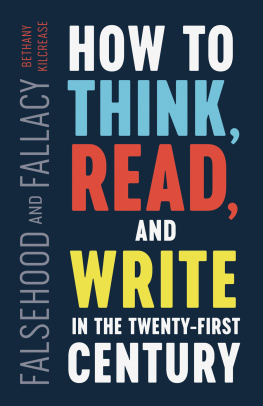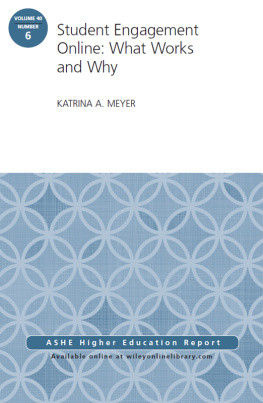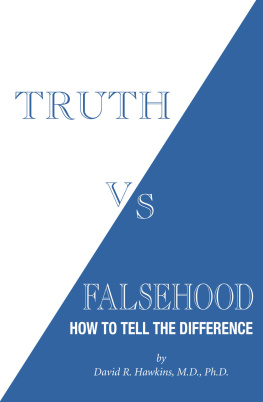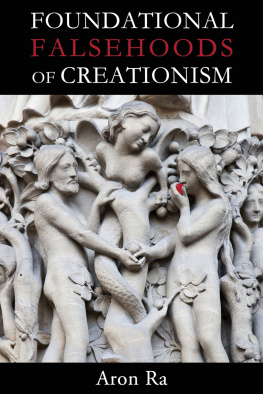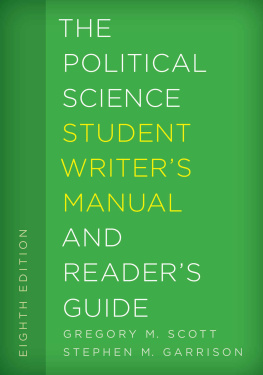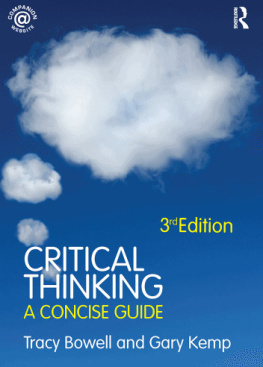
FALSEHOOD AND FALLACY
FALSEHOOD AND FALLACY
How to Think, Read, and Write in the Twenty-First Century
Bethany Kilcrease

Toronto Buffalo London
University of Toronto Press 2021
Toronto Buffalo London
utorontopress.com
Printed in Canada
ISBN 978-1-4875-8862-5 (cloth) ISBN 978-1-4875-8863-2 (EPUB)
ISBN 978-1-4875-8861-8 (paper) ISBN 978-1-4875-8864-9 (PDF)
All rights reserved. The use of any part of this publication reproduced, transmitted in any form or by any means, electronic, mechanical, photocopying, recording, or otherwise, or stored in a retrieval system, without prior written consent of the publisher or in the case of photocopying, a licence from Access Copyright, the Canadian Copyright Licensing Agency is an infringement of the copyright law.
Library and Archives Canada Cataloguing in Publication
Title: Falsehood and fallacy : how to think, read, and write in the twenty-first century /
Bethany Kilcrease.
Names: Kilcrease, Bethany, author.
Description: Includes bibliographical references and index.
Identifiers: Canadiana (print) 20200412310 | Canadiana (ebook) 20200412388 |
ISBN 9781487588625 (cloth) | ISBN 9781487588618 (paper) | ISBN 9781487588632
(EPUB) | ISBN 9781487588649 (PDF)
Subjects: LCSH: Critical thinking. | LCSH: Reading. | LCSH: Academic writing. |
LCSH: Research Methodology. | LCSH: Fallacies (Logic) | LCSH: Truthfulness
and falsehood. | LCSH: Information literacy. | LCSH: Electronic information
resource literacy.
Classification: LCC BF441 .K55 2021 | DDC 153.4/2dc23
We welcome comments and suggestions regarding any aspect of our publications please feel free to contact us at .
Every effort has been made to contact copyright holders; in the event of an error or omission, please notify the publisher.
University of Toronto Press acknowledges the financial assistance to its publishing program of the Canada Council for the Arts and the Ontario Arts Council, an agency of the Government of Ontario.

In memory of Dr. Brent Chesley and Dr. Mark Hoolihan
CONTENTS
PREFACE
I have now been teaching undergraduate students for over a decade. One consistent thing that I and I imagine pretty much all instructors have noticed in my classes is the need for teaching careful attention to source evaluation, reading, and writing. The book you are now holding in your hands began as a now defunct blog that I designed to partially meet this need. In its short life span, my blog, entitled History Writing Demystified for the Undergraduate Scholar, included short posts offering advice on topics such as taking notes in class, writing summaries of secondary sources, and recognizing informal logical fallacies. Im not sure how many students ever read my blog, but University of Toronto Press acquisitions editor Natalie Fingerhut discovered it and asked me to submit a book proposal based on some of its content. From there, writing fresh content commenced, and Id like to thank several individuals for reading (sometimes very) rough drafts of chapters. These include Julie Bevins, writing center coordinator; Shellie Jeffries, co-director of the Grace Hauenstein Library; Nalana La Framboise, writing consultant; Sarah K. Nytroe, associate professor of history; Molly Patterson, associate professor of political science; Gretchen Rumohr, associate professor of English; Holly Scheer, senior contributor to the Federalist; and Daniel Wagner, assistant professor of philosophy. I would also like to thank my husband, Dr. Jack Kilcrease, for reading several chapters; my daughters, Miriam and Ruth, for not keeping Mommy too busy to write; and the rest of my family.
CHAPTER 1
INTRODUCTION
Remember when Palestinians recognized Texas as a part of Mexico? Do you recall the time when the National Football League decided to fine each of the Pittsburgh Steelers one million dollars for remaining in their locker room during the national anthem? I certainly remember reading about both of these things. After all, based on the number of Google hits, these were among the most widely shared news stories on social media in 2017.
With trolls like Blair hard at work, should you trust what you read? Does it make a difference if the text came from a print book or off the internet? What about from a universitys website as opposed to a personal blog? Can you even remember a time before the internet? Do you know that at one time in the hoary past a face book was actually a physical paper book published by colleges as a photo directory? Hence the name Facebook. Did you grow up in a time before the smartphone functioned as a ubiquitous accessory in ones back (or front) pocket? If the answer is no, then you were probably born between the late 1990s and 2010s. Demographers refer to this generation as Generation Z or the Post-Millennial Generation. This generation is stereotypically seen as especially tech savvy, although in our screen-saturated environment, this can be true of students from all generations. Regardless of their generation, my students will often modestly claim, when asked, that they are not great readers and certainly do not consider themselves writers. But we know this is untrue. They consume an astonishing amount of digital text and produce an equally astonishing amount. Although popular platforms like Instagram and Snapchat are image based, most students still necessarily swim in a sea of words. After all, even these platforms make use of descriptive text, and texting itself is ubiquitous. You must constantly decipher both images and words in order to navigate real-life social relationships and politics. After all, it takes work both to organize your weekend plans via text message and to sort out Blairs ilk from more reliable content providers.
Students will often claim that they are neither great readers nor writers. But we know this is untrue. They consume an astonishing amount of digital text and produce an equally astonishing amount.
Many American undergraduate students have never known a world without constant internet access. And they have also never known a world without the so-called War on Terror and the conflicts that grew out of it. I vividly recall the events of 9/11 shattering my rather nave view of a peaceful and ordered world. Perhaps the COVID-19 pandemic functioned much the same for you. Those of us born well prior to the events of both 9/11 and the novel coronavirus pandemic may remember a seemingly stable world order presided over by the benevolent presence of American democracy. I rather doubt many of you see the world through this lens today. Not surprisingly, the way in which the United States responded to the events of 9/11 and subsequent events deeply divided both Americans and others around the world. Around two decades later, our elected leaders and citizens alike are still arguing over the extent to which Americans should remain involved in military activity in Afghanistan activity that began as a direct result of the 2001 terrorist attacks by Al Qaeda. Further debate continues over the extent to which the United States should engage newer terrorist groups like the Islamic State in Iraq and Syria ( ISIS ) around the world.
Next page
